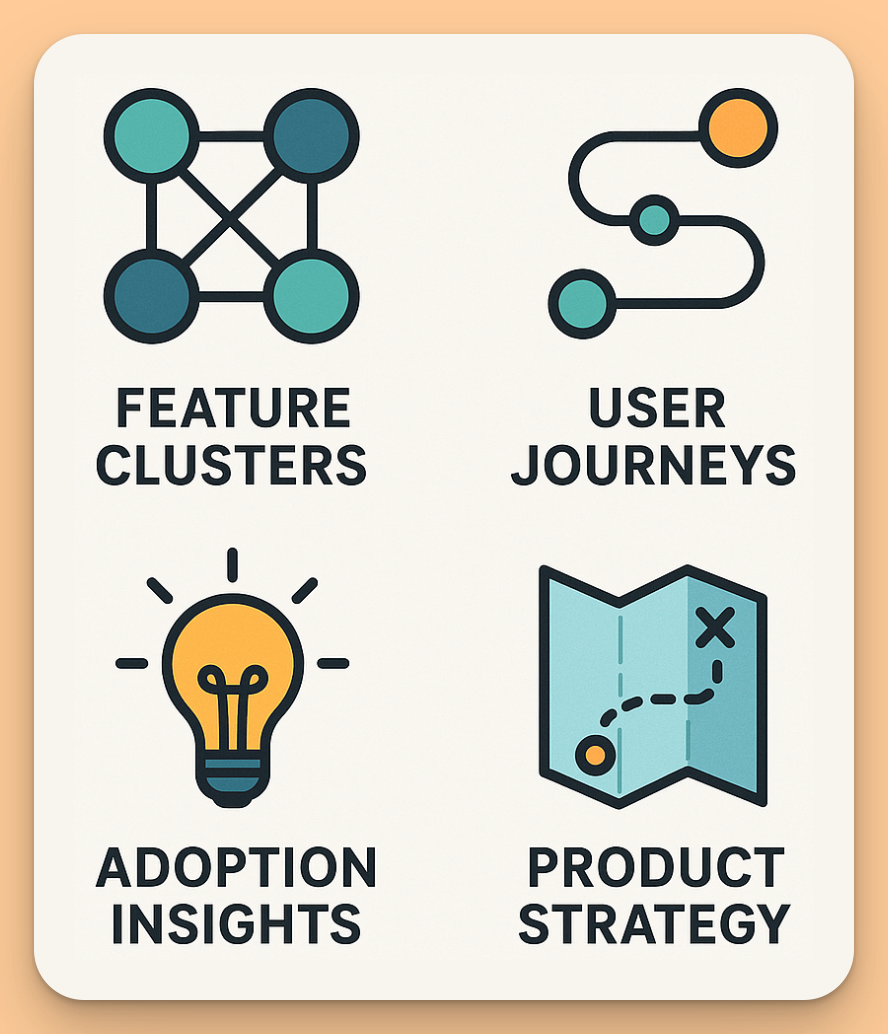When you hear Market Basket Analysis you probably think of a supermarket trying to figure out why people who buy diapers also tend to buy beer. For decades, retailers have used this technique to optimize store layouts and power online recommendation engines. It’s a proven method for understanding what customers buy together.
But what if we took that same powerful idea and applied it to what users do together?
For SaaS companies, app developers, and anyone with a digital product, your user activity data is a goldmine. By looking at your product through the lens of Market Basket Analysis, you can move beyond simple metrics like Daily Active Users and uncover the complex workflows and feature combinations that define how people truly find value in your product.
This guide will show you how to repurpose this classic analytics technique to not only understand your users on a deeper level but also to build a stickier, more intuitive product.
What is Market Basket Analysis in a Product Context?
Let's strip away the jargon. In a product analytics context, Market Basket Analysis is about identifying the features and actions that are frequently used together.
- The "Basket": Instead of a shopping cart, the basket is a single user session, or a user's activity over a specific period (e.g., a week).
- The "Items": Instead of products, the items are the distinct features, actions, or modules within your application.
The goal is to discover powerful associations. For example, you might find that "80% of users who use the 'Create Project' feature also use the 'Invite Team Member' feature within the same session." This simple insight is the first step toward understanding a core user workflow.

How This Revolutionizes Product & Usage Analysis
Applying this model to user behavior can unearth a wealth of actionable insights that are often invisible in standard analytics reports. It's a key part of building a truly data-driven product strategy.
- Discover "Feature Clusters": You can identify which features are natural companions in your users' minds. For example, do users who export a report (
feature A) almost always apply a specific filter (feature B) first? This "feature cluster" represents a core user workflow that you can optimize and promote. - Map Real User Journeys: Go beyond idealized funnels to see the organic, sometimes messy, paths users take to get their work done. This can reveal friction points or innovative workarounds that your users have invented, providing invaluable feedback for UI/UX improvements.
- Drive Strategic Feature Adoption: By identifying the feature sets used by your most successful, long-term customers ("power users"), you can create targeted onboarding flows or in-app guides that encourage new users to adopt these high-value patterns of behavior.
- Inform Your Product Roadmap: If you see users frequently using two basic features in tandem, it might be a sign that they need a more advanced, combined feature. This data-driven approach helps you prioritize development based on demonstrated user needs, not just requests.
- Create Smarter Upsell & Onboarding: Usage patterns can be strong buying signals. A user consistently hitting the limits of a "basic" feature is a prime candidate for an upgrade. Likewise, knowing the top three features most new users adopt in their first week allows you to create a laser-focused onboarding experience that delivers value immediately.

Why You Can't Afford to Ignore Your Product's "Digital Body Language"
In a competitive market, a deep understanding of user behavior is no longer a "nice-to-have"—it's essential for survival and growth. Relying on surface-level metrics alone is like trying to understand a conversation by only hearing every tenth word.
By analyzing feature co-occurrence, you gain a more complete picture, which leads to tangible business outcomes:
- Increased Retention: When a product intuitively supports a user's natural workflow, it becomes indispensable. Optimizing for these workflows makes your product "stickier" and reduces churn.
- Higher Engagement: By guiding users toward powerful feature combinations, you help them get more value out of your product, turning them from casual users into expert advocates.
- Improved Efficiency: Your product and marketing teams can work more effectively when they have clear data on which features drive the most value and for whom.
The best part? You don't need a massive data science team to get started. The logic behind Market Basket Analysis is accessible, and the insights are waiting in the user activity logs you already have.

Embrace the Future of Product Analytics
The most successful products are built on a deep empathy for the user. Market Basket Analysis, when applied to product usage, is a powerful tool for developing that empathy at scale. It allows you to listen to your users' collective "digital body language" and respond with a product that truly understands their needs.
Don't let the buzzwords intimidate you. The future of product development is understanding the hidden relationships in your data. It's time to see what your users' "baskets" can tell you.